Just Acquired - ‘74 Masi Gran Criterium (mostly, if not all, original condition)
#76
Senior Member
Join Date: Jan 2013
Location: Norman, Oklahoma
Posts: 5,395
Bikes: Too many to list
Mentioned: 36 Post(s)
Tagged: 0 Thread(s)
Quoted: 1765 Post(s)
Liked 1,124 Times
in
746 Posts
Ive been doing this since i got my first road bike way back when also . I came to the sport when life happened and motocross got too expensive for me --- the front brake on the left alwys felt odd to me
#77
www.theheadbadge.com
Join Date: Sep 2005
Location: Southern Florida
Posts: 28,514
Bikes: https://www.theheadbadge.com
Mentioned: 124 Post(s)
Tagged: 0 Thread(s)
Quoted: 2422 Post(s)
Liked 4,396 Times
in
2,093 Posts
That's one hell of a bow. I can't imagine it being something resulting from the top tube being inserted last, or even something from the heat. The bow suggests there's sprung tension on it, as if the downtube shrunk. Perhaps the lower headlug or BB were brazed in last, and they kept coming up a bit short in mitering?
Really? Did we need to go all OT with the A&S stuff? All because this Masi had a reflector
-Kurt
Really? Did we need to go all OT with the A&S stuff? All because this Masi had a reflector

-Kurt
Last edited by cudak888; 06-29-21 at 08:39 PM.
#78
Full Member
Thread Starter
Join Date: May 2013
Location: Tropical Montana
Posts: 401
Mentioned: 13 Post(s)
Tagged: 0 Thread(s)
Quoted: 225 Post(s)
Liked 1,101 Times
in
327 Posts
I have an Italian Masi GC that my parents picked up for me in Milan in late summer 1972. It has a top tube height variation of 6mm. I measured it extremely carefully for my frame building colleague Rich Gangl that was making a Masi tribute bike just like the one he rode in his early racing days. My fixtures are very good at displaying all geometry dimensions. Somehow a private email group of Masi owners got started from a Classic Rendezvous posting and everyone was measuring their top tube slope. The range was something from 3 to 9 mm.
I'm curious what caused these variations? I've understood that they had master frames of each size that set their fixtures and perhaps those are off a bit. Or did they build them like some British builders sliding the top tube on last when the rest of the frame is out the jig so it didn't end up perfectly level?
I'm curious what caused these variations? I've understood that they had master frames of each size that set their fixtures and perhaps those are off a bit. Or did they build them like some British builders sliding the top tube on last when the rest of the frame is out the jig so it didn't end up perfectly level?
That's one hell of a bow. I can't imagine it being something resulting from the top tube being inserted last, or even something from the heat. The bow suggests there's sprung tension on it, as if the downtube shrunk. Perhaps the lower headlug or BB were brazed in last, and they kept coming up a bit short in mitering?
[…]
-Kurt
[…]
-Kurt
[…]
Knowing the bikes well and in the review of the images it was clear that the top tube was rising.
The detail that the top tube was not perfectly straight is not an issue. The dirty little secret of both major tube makers is that the tubes are not always perfectly straight.
A thoughtful builder will place a tube "wow" in a plane that does not effect anything.
Salamandrine was correct in his mention that extra rake reduces trail, I missed that in my response. A thoughtful comment. It is kind of counter-intuitive... then there is a discussion of mechanical trail and wheel flop...
Bikes are quite tolerant of significant variation and still "work"
I do find in interesting that Falerio did not correct the USA jig frame set. Perhaps a non issue to him.
__________________
Montana, where men are men and sheep are lying little tramps.
Montana, where men are men and sheep are lying little tramps.
Last edited by majmt; 06-29-21 at 09:52 PM.
#79
Full Member
Thread Starter
Join Date: May 2013
Location: Tropical Montana
Posts: 401
Mentioned: 13 Post(s)
Tagged: 0 Thread(s)
Quoted: 225 Post(s)
Liked 1,101 Times
in
327 Posts
You need the little dabs of Yellow paint painted on the top tube clip fasteners- actually they snipped the screws off first originally.
the cable ends had cuffs crimped near the end of the cables- not the closed ones commonly available. Those and the cable ends were painted yellow as well in the case of this color of bike.
now you need to find a white Silca frame fit pump and get it painted to match the color of the bike ( no clear coat required )
and there was a German eBay seller selling ALE water bottles with the decoration for a reasonable price- buy two so you get the white cap, there are others about for silly prices.
I rode my Carlsbad GC this morning.
mine could use a cleaning, a month of use dirty.
the cable ends had cuffs crimped near the end of the cables- not the closed ones commonly available. Those and the cable ends were painted yellow as well in the case of this color of bike.
now you need to find a white Silca frame fit pump and get it painted to match the color of the bike ( no clear coat required )
and there was a German eBay seller selling ALE water bottles with the decoration for a reasonable price- buy two so you get the white cap, there are others about for silly prices.
I rode my Carlsbad GC this morning.
mine could use a cleaning, a month of use dirty.
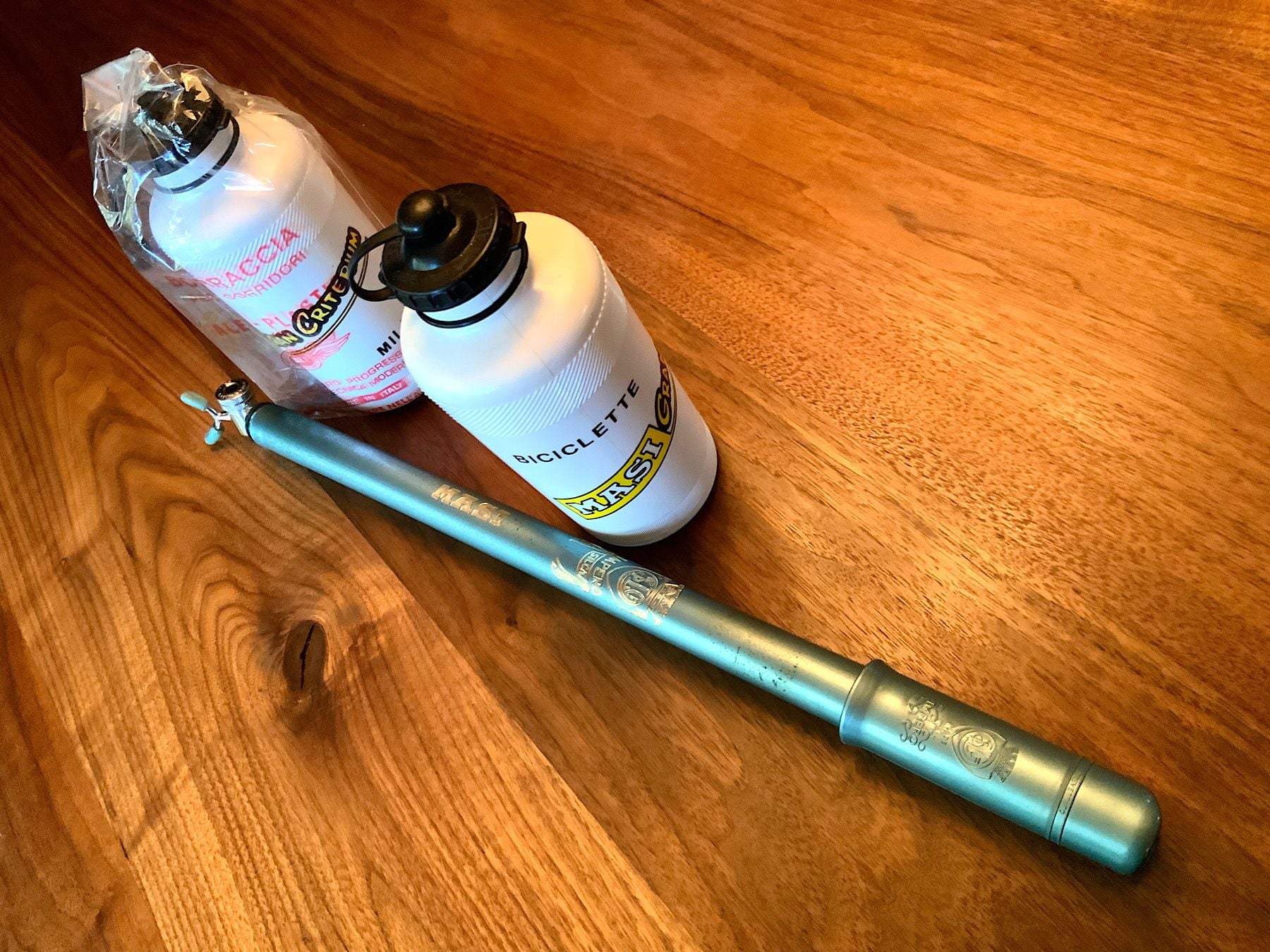
The bike was supposed to come with the original pump but the box the bike was shipped in was damaged and there was a hole where I figured that the unobtainium pump had been sucked into UPS purgatory. Turned out that the eBay seller took it off for safe keeping while the bike was being packed and then forgot to include it the package. He later sent it along. It doesn’t really work that well - probably needs new leather. But, it is the correct pump although I’ll probably just save it as an ornament.
I did get a pair of the ALE Masi bottles, I couldn’t find any with the white tops but I’ll keep looking for any bottle with a correct top to salvage.
I rode mine this morning too. Easily up a steep grade and down the other side fast and stable. I have a couple other top-shelf bikes and I’ll say again that this is the finest bike I’ve ever had. I love the feel of it, even over my Ottrott. And, although it’s 47 years old, I’m pretty sure it’s my fastest bike now. But then, I don’t own a road bike that’s less than 10 years old either.
__________________
Montana, where men are men and sheep are lying little tramps.
Montana, where men are men and sheep are lying little tramps.
Last edited by majmt; 06-29-21 at 11:03 PM.
#80
Full Member
Thread Starter
Join Date: May 2013
Location: Tropical Montana
Posts: 401
Mentioned: 13 Post(s)
Tagged: 0 Thread(s)
Quoted: 225 Post(s)
Liked 1,101 Times
in
327 Posts
@majmt
Some here may disagree but the tire saver on the front should go the other way, under the crown.
If it catches and wads up it can take you down and do a lot of damage by itself, never mind the damage to the bike from going down.
They can catch going either way but may pull apart when pointing forward, more likely to wad up if it catches when its pointing rearward.
Beautiful bike, very nice job you're doing with it.
Some here may disagree but the tire saver on the front should go the other way, under the crown.
If it catches and wads up it can take you down and do a lot of damage by itself, never mind the damage to the bike from going down.

They can catch going either way but may pull apart when pointing forward, more likely to wad up if it catches when its pointing rearward.
Beautiful bike, very nice job you're doing with it.

__________________
Montana, where men are men and sheep are lying little tramps.
Montana, where men are men and sheep are lying little tramps.
#81
www.theheadbadge.com
Join Date: Sep 2005
Location: Southern Florida
Posts: 28,514
Bikes: https://www.theheadbadge.com
Mentioned: 124 Post(s)
Tagged: 0 Thread(s)
Quoted: 2422 Post(s)
Liked 4,396 Times
in
2,093 Posts
Now that you highlight these two comments in context, I see where I interpreted it incorrectly - for a moment, I thought the top tubes were bowed 6mm (!). Sloping 6mm makes a lot more sense. Curious if the drop was proportional to frame size - thus intentional - or completely random. (Side note: If random, this would be an interesting test to expand to other manufacturers of the period).
Either way, it's the one tube in the frame that a builder doesn't have to be as particular about. The head and seat tube angles yes. Bottom bracket/chainstay drop, yes. Top tube? There for the strength, primarily, and no different if sloping or otherwise.
-Kurt
Either way, it's the one tube in the frame that a builder doesn't have to be as particular about. The head and seat tube angles yes. Bottom bracket/chainstay drop, yes. Top tube? There for the strength, primarily, and no different if sloping or otherwise.
-Kurt
#82
Senior Member
Join Date: Jun 2006
Posts: 20,305
Mentioned: 130 Post(s)
Tagged: 0 Thread(s)
Quoted: 3464 Post(s)
Liked 2,831 Times
in
1,997 Posts
yep- Falerio goofed, if you must have a level top tube.
Mario did make some corrections at least for the later Carlsbad GC’s but not completely.
I have a slew of these bikes. A slew defined as 15.
The most curious is a 1974 Italian GC with a rising top tube of 8 mm. One would have expected that things might have been ironed out by then.
from my referencing, Alberto “fixed” the Prestige and Volumetrica.
later USA GC’s, Moulton and Starck era had level top tubes. Comparing those two and they are really different bikes from the Italian and Carlsbad designs. Short reach brakes made this easier in my view.
good the pump is about, that gold foil Masi on the barrel is unobtanium. I am working on it though.
for the waterbottles, the fastest way I think to get to the original look is reference the German eBay seller selling various ALE bottles - some with white caps- then mix and match.
Mario did make some corrections at least for the later Carlsbad GC’s but not completely.
I have a slew of these bikes. A slew defined as 15.
The most curious is a 1974 Italian GC with a rising top tube of 8 mm. One would have expected that things might have been ironed out by then.
from my referencing, Alberto “fixed” the Prestige and Volumetrica.
later USA GC’s, Moulton and Starck era had level top tubes. Comparing those two and they are really different bikes from the Italian and Carlsbad designs. Short reach brakes made this easier in my view.
good the pump is about, that gold foil Masi on the barrel is unobtanium. I am working on it though.
for the waterbottles, the fastest way I think to get to the original look is reference the German eBay seller selling various ALE bottles - some with white caps- then mix and match.
#83
Senior Member
Join Date: Jun 2006
Posts: 20,305
Mentioned: 130 Post(s)
Tagged: 0 Thread(s)
Quoted: 3464 Post(s)
Liked 2,831 Times
in
1,997 Posts
Now that you highlight these two comments in context, I see where I interpreted it incorrectly - for a moment, I thought the top tubes were bowed 6mm (!). Sloping 6mm makes a lot more sense. Curious if the drop was proportional to frame size - thus intentional - or completely random. (Side note: If random, this would be an interesting test to expand to other manufacturers of the period).
Either way, it's the one tube in the frame that a builder doesn't have to be as particular about. The head and seat tube angles yes. Bottom bracket/chainstay drop, yes. Top tube? There for the strength, primarily, and no different if sloping or otherwise.
-Kurt
Either way, it's the one tube in the frame that a builder doesn't have to be as particular about. The head and seat tube angles yes. Bottom bracket/chainstay drop, yes. Top tube? There for the strength, primarily, and no different if sloping or otherwise.
-Kurt
#84
www.theheadbadge.com
Join Date: Sep 2005
Location: Southern Florida
Posts: 28,514
Bikes: https://www.theheadbadge.com
Mentioned: 124 Post(s)
Tagged: 0 Thread(s)
Quoted: 2422 Post(s)
Liked 4,396 Times
in
2,093 Posts
#85
Senior Member
Join Date: Jun 2006
Posts: 20,305
Mentioned: 130 Post(s)
Tagged: 0 Thread(s)
Quoted: 3464 Post(s)
Liked 2,831 Times
in
1,997 Posts
I have a number of tube sets kicking around
Tange is the straightest from my observation
#86
Senior Member
Join Date: Jun 2008
Location: Louisville, KY
Posts: 13,447
Mentioned: 33 Post(s)
Tagged: 0 Thread(s)
Quoted: 4236 Post(s)
Liked 2,949 Times
in
1,808 Posts
Are they a little out, or are we talking 2x4's at home depot out of whack?
Likes For himespau:
#87
framebuilder
You might wonder why tubing manufacturers don't make more perfect tubing and the answer is because it would increase the cost with the result that they lose market share. The Japanese tubing in my experience has tighter tolerances than tubing from Italy or England.
#88
Senior Member
Join Date: Jun 2006
Posts: 20,305
Mentioned: 130 Post(s)
Tagged: 0 Thread(s)
Quoted: 3464 Post(s)
Liked 2,831 Times
in
1,997 Posts
I have an Italian Masi GC that my parents picked up for me in Milan in late summer 1972. It has a top tube height variation of 6mm. I measured it extremely carefully for my frame building colleague Rich Gangl that was making a Masi tribute bike just like the one he rode in his early racing days. My fixtures are very good at displaying all geometry dimensions. Somehow a private email group of Masi owners got started from a Classic Rendezvous posting and everyone was measuring their top tube slope. The range was something from 3 to 9 mm.
I'm curious what caused these variations? I've understood that they had master frames of each size that set their fixtures and perhaps those are off a bit. Or did they build them like some British builders sliding the top tube on last when the rest of the frame is out the jig so it didn't end up perfectly level?
I'm curious what caused these variations? I've understood that they had master frames of each size that set their fixtures and perhaps those are off a bit. Or did they build them like some British builders sliding the top tube on last when the rest of the frame is out the jig so it didn't end up perfectly level?
At one point Mr. Fattic had a later Carlsbad Masi frame at his shop... I think a 56 Masi Measure in Spanish Blue, be interesting to hear how it measures out.
Hint, hint.
#89
Senior Member
Join Date: Jun 2006
Posts: 20,305
Mentioned: 130 Post(s)
Tagged: 0 Thread(s)
Quoted: 3464 Post(s)
Liked 2,831 Times
in
1,997 Posts
I have an Italian Masi GC that my parents picked up for me in Milan in late summer 1972. It has a top tube height variation of 6mm. I measured it extremely carefully for my frame building colleague Rich Gangl that was making a Masi tribute bike just like the one he rode in his early racing days. My fixtures are very good at displaying all geometry dimensions. Somehow a private email group of Masi owners got started from a Classic Rendezvous posting and everyone was measuring their top tube slope. The range was something from 3 to 9 mm.
I'm curious what caused these variations? I've understood that they had master frames of each size that set their fixtures and perhaps those are off a bit. Or did they build them like some British builders sliding the top tube on last when the rest of the frame is out the jig so it didn't end up perfectly level?
I'm curious what caused these variations? I've understood that they had master frames of each size that set their fixtures and perhaps those are off a bit. Or did they build them like some British builders sliding the top tube on last when the rest of the frame is out the jig so it didn't end up perfectly level?
After Mario departed, much intellectual property went with. Long go Brian reported that when Albert Eisentraut was reviewing the jig frames to take dimensions for the contract bikes he was to make, he was perplexed, "this is wrong" as Brian reported back on the old CR bikelist.
It does show that there can be quite a variation and a bike is still rideable.
Masi geometry evolved at least twice after Carlsbad. I have a 55 from 1981, and a 55 from the mid 80's and they are both different again.
to be overly clear, the Carlsbad bikes (and Confentes later) had the forks brazed up with blades straight, and the rake was induced over a heavy steel fixture mounted securely to a sturdy worktable. It retained the dropouts and with a long cheater bar slid over the steerer, the blades were curved over. There were check guides I will call them to review the fairness of the parabolic curve but not the actual offset. A different set for the track bikes.
An interesting mix of control and variability.
#90
Senior Member
Join Date: Apr 2005
Location: Ann Arbor, MI
Posts: 16,880
Bikes: 1980 Masi, 1984 Mondonico, 1984 Trek 610, 1980 Woodrup Giro, 2005 Mondonico Futura Leggera ELOS, 1967 PX10E, 1971 Peugeot UO-8
Mentioned: 49 Post(s)
Tagged: 0 Thread(s)
Quoted: 1858 Post(s)
Liked 664 Times
in
506 Posts
I’ve been a bit confused about a few things but just had few thoughts after seeing the comments. First, per repechage, the bikes leaving the Carlsbad shop would have had Everest freewheels and chains, had yellow dabs of paint on the top tube guides and cable ends, probably different tires, and had yellow or white handlebar tape with different plugs. Salamandrine pointed out the extreme forward position of the rear wheel and you can even see that the original position was further back in the drop out. Yet, looking at the overall condition of the bike, I would guess that it was barely ridden enough to warrant replacing anything - everything really does look original.
It looks like the original point of sale was in Concord CA from the shop decal on the bottom of the seat tube and that coincides with the bike coming from the SF Bay Area. I’m thinking that the modifications may have been done at the bike shop before it ever hit the road. It makes sense that the original freewheel may have been swapped for the 14-28T Regina with a wider range for riding in SF. That may have required a different chain as well as moving the wheel forward to reduce interference. Also, the original owner may have requested that the bike shop reverse the brake routing which could’ve required modification or even replacement of the rear brake cabling along the top tube explaining why the routing guides are different than when it left Carlsbad. Maybe they rewrapped the handlebars in the process too.
Does any of that make sense?
It looks like the original point of sale was in Concord CA from the shop decal on the bottom of the seat tube and that coincides with the bike coming from the SF Bay Area. I’m thinking that the modifications may have been done at the bike shop before it ever hit the road. It makes sense that the original freewheel may have been swapped for the 14-28T Regina with a wider range for riding in SF. That may have required a different chain as well as moving the wheel forward to reduce interference. Also, the original owner may have requested that the bike shop reverse the brake routing which could’ve required modification or even replacement of the rear brake cabling along the top tube explaining why the routing guides are different than when it left Carlsbad. Maybe they rewrapped the handlebars in the process too.
Does any of that make sense?
#91
Senior Member
Join Date: Jun 2006
Posts: 20,305
Mentioned: 130 Post(s)
Tagged: 0 Thread(s)
Quoted: 3464 Post(s)
Liked 2,831 Times
in
1,997 Posts
A few received Blue tape, in general those were bikes with a blue background in the Downtube graphic panel and blue fill on the chainstay type.
For the yellow or the silver bikes ( sometimes )
no idea how judgements were decided.
that the bike was modified before it left the bike shop, saw it frequently.
rare was the bike that left with Hunt- Wilde plugs. ( the result of an oversight in the parts package sent over from Italy )
there were lots of potential changes. As time went on, there were custom order components, SL pedals, freewheel gearing, saddle, bars and stem, there was an interval of 3ttt bar and stem, the stem engraved, the bars decorated with a custom Masi stamp. And later, braze-ons- shifter bosses being the most common.
Most of all this was “off menu” they really wanted to keep things uniform.
For the yellow or the silver bikes ( sometimes )
no idea how judgements were decided.
that the bike was modified before it left the bike shop, saw it frequently.
rare was the bike that left with Hunt- Wilde plugs. ( the result of an oversight in the parts package sent over from Italy )
there were lots of potential changes. As time went on, there were custom order components, SL pedals, freewheel gearing, saddle, bars and stem, there was an interval of 3ttt bar and stem, the stem engraved, the bars decorated with a custom Masi stamp. And later, braze-ons- shifter bosses being the most common.
Most of all this was “off menu” they really wanted to keep things uniform.
#92
Full Member
Thread Starter
Join Date: May 2013
Location: Tropical Montana
Posts: 401
Mentioned: 13 Post(s)
Tagged: 0 Thread(s)
Quoted: 225 Post(s)
Liked 1,101 Times
in
327 Posts
 Just when I think that I may know a thing or two about bikes, I read through these CV threads and realize that I’m really pretty clueless. I really appreciate the expert knowledge shared here.
Just when I think that I may know a thing or two about bikes, I read through these CV threads and realize that I’m really pretty clueless. I really appreciate the expert knowledge shared here.Glad to see this thread exhumed. We’re planning to do the CA Eroica this year and I was thinking that this bike might be an interesting entry into the Concours d’Elegance. I haven’t modified anything and the swaps that I’ve made to conserve original components can be easily reversed. I’d like to see how it might score in the “Original” class and I’d like to stay true to original spec but I’m not sure if re-taping, adding cable crimps, and the daubs of yellow paint etc would be considered restoration. I know nothing about showing a bike.
I’m really thinking that this bike first hit the road as shown below after probably being customized a bit at the time of original purchase from the Bicycle Shop in Concord, CA when it first opened.
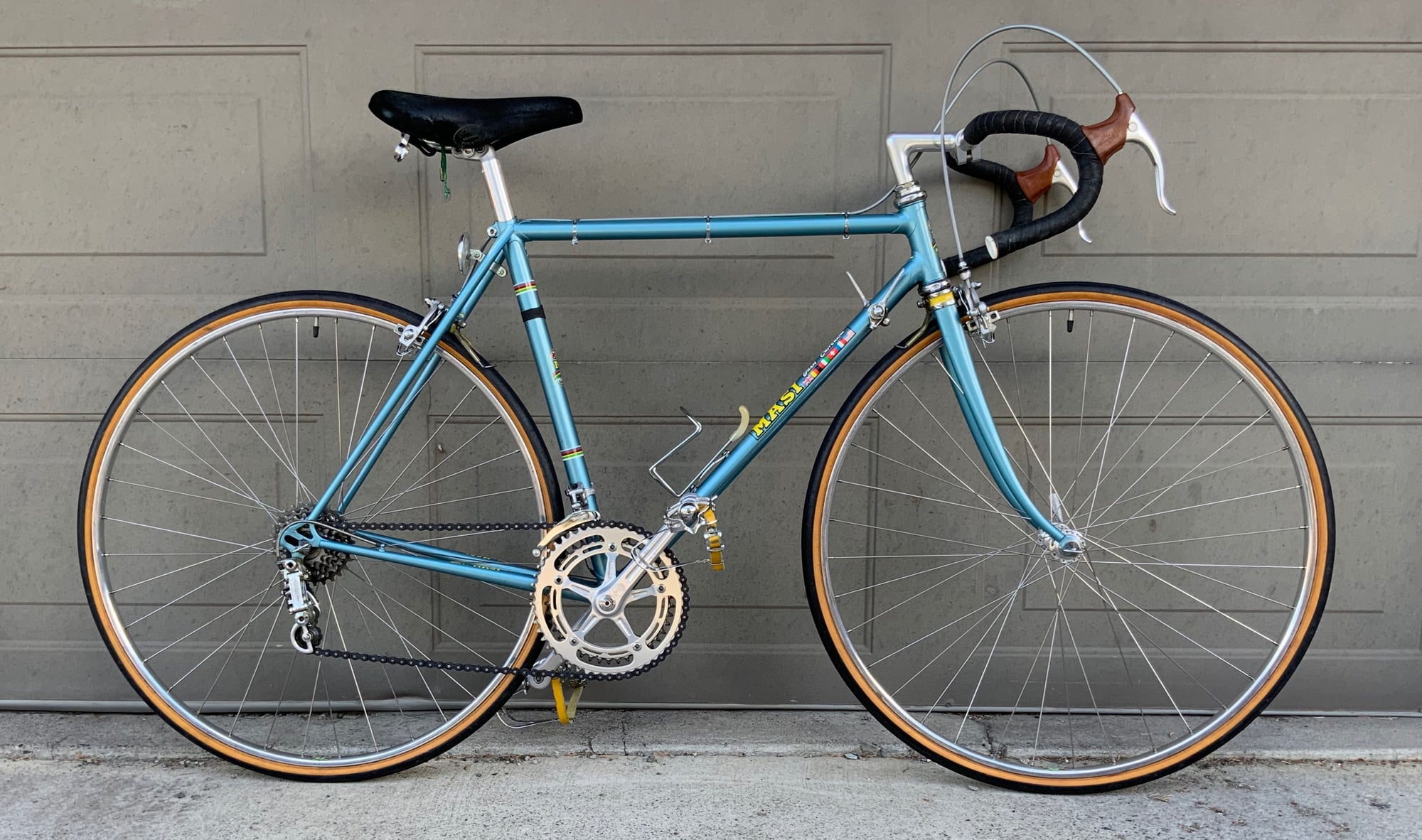

__________________
Montana, where men are men and sheep are lying little tramps.
Montana, where men are men and sheep are lying little tramps.
Last edited by majmt; 12-29-21 at 08:19 AM.
Likes For majmt:
#93
Senior Member
Join Date: Apr 2005
Location: Ann Arbor, MI
Posts: 16,880
Bikes: 1980 Masi, 1984 Mondonico, 1984 Trek 610, 1980 Woodrup Giro, 2005 Mondonico Futura Leggera ELOS, 1967 PX10E, 1971 Peugeot UO-8
Mentioned: 49 Post(s)
Tagged: 0 Thread(s)
Quoted: 1858 Post(s)
Liked 664 Times
in
506 Posts
I’ll have to put together a posting on my 1980 littler GC, and a photo of how I measure fork offset. I finally gave up on looking at pictures and waiting for “the number” to swim into my head. I can check offset pretty easily, but I have to have the frame off of the bike. I can also measure it pretty roughly by a method involving kneeling next to the fork with a yardstick and a small scale trying to hold all three of these (four If you include the bike) stationary in mid air as I read the scale. I think I’m too old for that now!
#94
Senior Member
Join Date: Jun 2006
Posts: 20,305
Mentioned: 130 Post(s)
Tagged: 0 Thread(s)
Quoted: 3464 Post(s)
Liked 2,831 Times
in
1,997 Posts
I’ll have to put together a posting on my 1980 littler GC, and a photo of how I measure fork offset. I finally gave up on looking at pictures and waiting for “the number” to swim into my head. I can check offset pretty easily, but I have to have the frame off of the bike. I can also measure it pretty roughly by a method involving kneeling next to the fork with a yardstick and a small scale trying to hold all three of these (four If you include the bike) stationary in mid air as I read the scale. I think I’m too old for that now!
#95
Senior Member
Join Date: Apr 2005
Location: Ann Arbor, MI
Posts: 16,880
Bikes: 1980 Masi, 1984 Mondonico, 1984 Trek 610, 1980 Woodrup Giro, 2005 Mondonico Futura Leggera ELOS, 1967 PX10E, 1971 Peugeot UO-8
Mentioned: 49 Post(s)
Tagged: 0 Thread(s)
Quoted: 1858 Post(s)
Liked 664 Times
in
506 Posts
Basically I take off the fork and set it on a flat level surface with the blades resting on the dropouts. I clamp a bare front wheel hub into the dropouts, then put a level on the steer tube and put blocks or stuff under the steer tube until the level on the steer tube indicates 0 degrees slant. Now the axis of the dropouts is the centerline of the axle or QR, and the axis of the steer tube is the steering axis of the bike (I assume these two identities are true; call them axioms.). With digital calipers I can make a differential measurement of the axle and compute the height of the wheel axis above the flat surface. I can similarly measure/compute the height of the steering axis above the flat surface. The difference between the height of the steering axis and the height of the wheel axis is the fork offset. At that point I can use the commonly known trail equation and the measured head tube angle, the measured radius of my wheel, and the offset to compute trail in millimeters. From there I can compute flop if I want, as well. Pretty basic mathematics, just have to collect reasonably accurate input data. By far the most difficult is the fork offset.
It's also possible to check for a twisted fork by placing a digital angle gauge on the fork crown running perpendicular to the steering axis, to check if the fork crown is showing any tilt. If the fork crown is symmetrically shaped and the digital angle reading is 0 degrees, I assume the fork blades are bent symmetrically.
That is my method. It works well enough, without any truly special tooling. And I don't have to drive 200 miles round trip, when it's convenient for somebody else.
Feel free to ask me questions if it is not clear.
Last edited by Road Fan; 12-29-21 at 01:50 PM.
Likes For Road Fan:
#96
Senior Member
Join Date: Jun 2006
Posts: 20,305
Mentioned: 130 Post(s)
Tagged: 0 Thread(s)
Quoted: 3464 Post(s)
Liked 2,831 Times
in
1,997 Posts
Doug has a scaled sliding apparatus- mimics the tubes, and the fork key numbers, the most recent was cut and marked in the Ukraine.
quick, accurate. Easy.
quick, accurate. Easy.
#97
Senior Member
Join Date: Apr 2005
Location: Ann Arbor, MI
Posts: 16,880
Bikes: 1980 Masi, 1984 Mondonico, 1984 Trek 610, 1980 Woodrup Giro, 2005 Mondonico Futura Leggera ELOS, 1967 PX10E, 1971 Peugeot UO-8
Mentioned: 49 Post(s)
Tagged: 0 Thread(s)
Quoted: 1858 Post(s)
Liked 664 Times
in
506 Posts
Bottom line, I have an approach which works for me.
If anyone wants to try it, have at it! I’ll try to answer questions if what I wrote is hard to understand (pics or a sketch would be reasonable, huh?). I do not believe it has master machinist accuracy. I think it can give a good idea what your trail is and maybe help you understand if your frame is within some range of the manufacturer’s spec. I would not consider it evidence of for example errors published in BQ or to fuel complaints about inaccurate geometry charts in the old Trek catalogs.
Last edited by Road Fan; 12-30-21 at 07:19 AM.
#98
Senior Member
Join Date: Jun 2006
Posts: 20,305
Mentioned: 130 Post(s)
Tagged: 0 Thread(s)
Quoted: 3464 Post(s)
Liked 2,831 Times
in
1,997 Posts
Don’t get me wrong or paint me wrong! I have seen Doug’s stuff a number of years ago. You’re correct about the quality of Doug’s ability and equipment. I will never argue that what I’m doing is better than what he is doing. But I don’t need that level of precision, since I do not build frames at the top level nor at any level. I also want to be able to measure my bikes or those of friends without a long drive to an expert’s shop. If for example I got Doug to build me a frame, I would tell him to use my technique. You don’t tell a master professional craftsman how to do his job.
Bottom line, I have an approach which works for me.
If anyone wants to try it, have at it! I’ll try to answer questions if what I wrote is hard to understand (pics or a sketch would be reasonable, huh?). I do not believe it has master machinist accuracy. I think it can give a good idea what your trail is and maybe help you understand if your frame is within some range of the manufacturer’s spec. I would not consider it evidence of for example errors published in BQ or to fuel complaints about inaccurate geometry charts in the old Trek catalogs.
Bottom line, I have an approach which works for me.
If anyone wants to try it, have at it! I’ll try to answer questions if what I wrote is hard to understand (pics or a sketch would be reasonable, huh?). I do not believe it has master machinist accuracy. I think it can give a good idea what your trail is and maybe help you understand if your frame is within some range of the manufacturer’s spec. I would not consider it evidence of for example errors published in BQ or to fuel complaints about inaccurate geometry charts in the old Trek catalogs.
#99
Senior Member
Join Date: Jun 2006
Posts: 20,305
Mentioned: 130 Post(s)
Tagged: 0 Thread(s)
Quoted: 3464 Post(s)
Liked 2,831 Times
in
1,997 Posts
I'm sure he does, and we've talked a few times. But it's not like he has an LBS where he welcomes people to just come in and gab or just to take advantage of his special capabiities in measurement. I know with his reference tables he can make a measurably flat, level surface, within the limits of his measuring tools. I'm nowhere so well equipped, and I don't think I need such accuracy. But, if I measure 60 mm offset and compute whatever, 30mm trail, I would like to know my trail is within a few mm of the truth. The math does not have noise or variability since I am a skilled calculator, but the input data can be variable. That's why I found a way better than my old multiple straightedge method, which I no longer use. I have a digital angle measuring device for the head tube slant.
Basically I take off the fork and set it on a flat level surface with the blades resting on the dropouts. I clamp a bare front wheel hub into the dropouts, then put a level on the steer tube and put blocks or stuff under the steer tube until the level on the steer tube indicates 0 degrees slant. Now the axis of the dropouts is the centerline of the axle or QR, and the axis of the steer tube is the steering axis of the bike (I assume these two identities are true; call them axioms.). With digital calipers I can make a differential measurement of the axle and compute the height of the wheel axis above the flat surface. I can similarly measure/compute the height of the steering axis above the flat surface. The difference between the height of the steering axis and the height of the wheel axis is the fork offset. At that point I can use the commonly known trail equation and the measured head tube angle, the measured radius of my wheel, and the offset to compute trail in millimeters. From there I can compute flop if I want, as well. Pretty basic mathematics, just have to collect reasonably accurate input data. By far the most difficult is the fork offset.
It's also possible to check for a twisted fork by placing a digital angle gauge on the fork crown running perpendicular to the steering axis, to check if the fork crown is showing any tilt. If the fork crown is symmetrically shaped and the digital angle reading is 0 degrees, I assume the fork blades are bent symmetrically.
That is my method. It works well enough, without any truly special tooling. And I don't have to drive 200 miles round trip, when it's convenient for somebody else.
Feel free to ask me questions if it is not clear.
Basically I take off the fork and set it on a flat level surface with the blades resting on the dropouts. I clamp a bare front wheel hub into the dropouts, then put a level on the steer tube and put blocks or stuff under the steer tube until the level on the steer tube indicates 0 degrees slant. Now the axis of the dropouts is the centerline of the axle or QR, and the axis of the steer tube is the steering axis of the bike (I assume these two identities are true; call them axioms.). With digital calipers I can make a differential measurement of the axle and compute the height of the wheel axis above the flat surface. I can similarly measure/compute the height of the steering axis above the flat surface. The difference between the height of the steering axis and the height of the wheel axis is the fork offset. At that point I can use the commonly known trail equation and the measured head tube angle, the measured radius of my wheel, and the offset to compute trail in millimeters. From there I can compute flop if I want, as well. Pretty basic mathematics, just have to collect reasonably accurate input data. By far the most difficult is the fork offset.
It's also possible to check for a twisted fork by placing a digital angle gauge on the fork crown running perpendicular to the steering axis, to check if the fork crown is showing any tilt. If the fork crown is symmetrically shaped and the digital angle reading is 0 degrees, I assume the fork blades are bent symmetrically.
That is my method. It works well enough, without any truly special tooling. And I don't have to drive 200 miles round trip, when it's convenient for somebody else.
Feel free to ask me questions if it is not clear.
Masi has another possible item to note that if one makes the wrong assumption will lead you astray- assuming the top tube is level.
for the handling geometry, one needs to work axle centers as the horizontal plane.
there are other brands that stray in this way as well, some 60’s-70’s paramounts.
#100
framebuilder
Here are the pictures showing my Masi that I got from Milan in September of 1972. I had my letters in English translated into Italian so the size could be determined. The slightly sloping top tube threw off my seat and head angle measurements when I made a frame for myself when I was learning how to build frames in England, I unintentionally choose seat and head angles based on their relationship to the Masi's top tube instead of the ground.
One of the benefits I've gotten from our charity bicycle project in Ukraine is that the laser company that made our dropouts and fork crowns (and other attachments) could also help refine the design of my frame fixture before they cut and etched the pieces from a plate of stainless steel. Over many years I've been able to make a number of refinements with the help of various people. It is multifunctional. I can custom design a frame on it by placing the chosen seat and stem in the position required after a fitting session. I also can spot tubes together into a frame before fully brazing them together.
I don't mind visitors to my frame shop and have no trouble explaining any time restrictions I may have because of work obligations. If I am in the middle of a frame building class of course I have to focus on the paying customer.
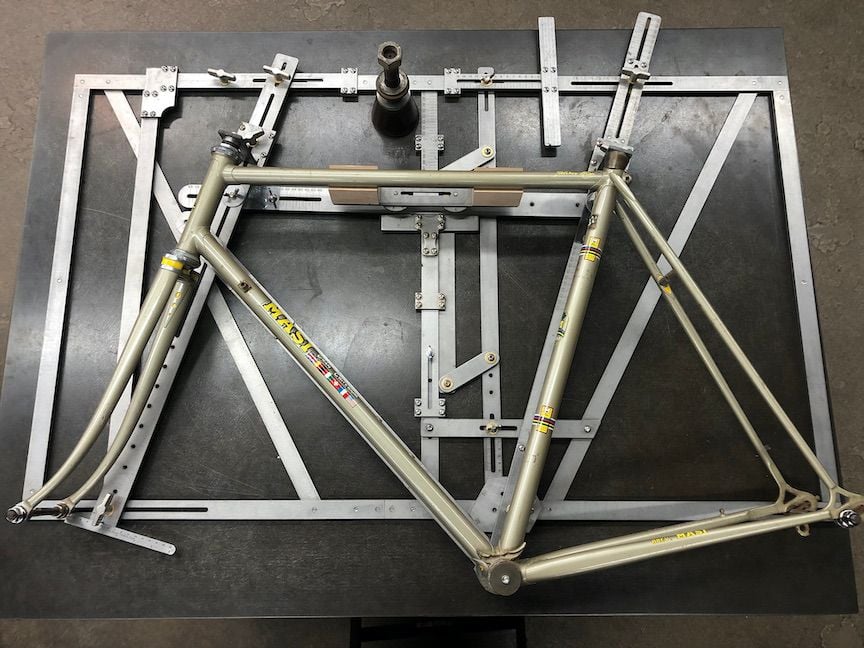
A picture of my 72 Masi in my frame fixture
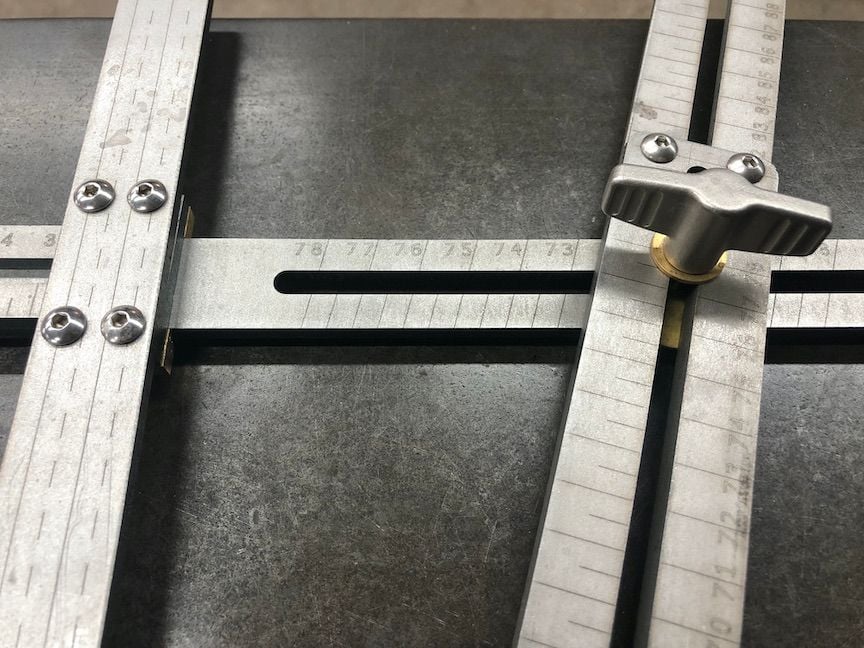
Its seat tube angle is 72.5º
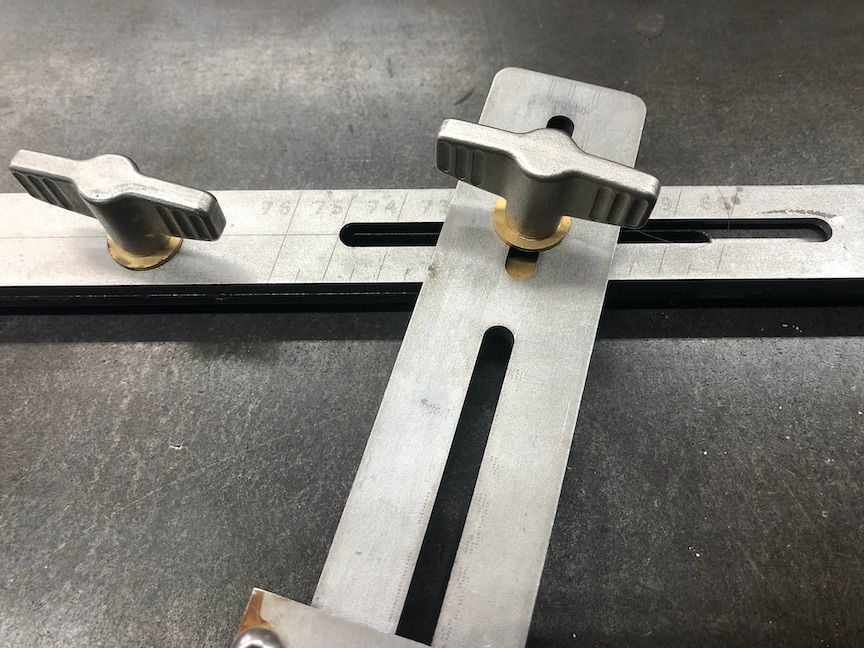
It head tube angle is 73º
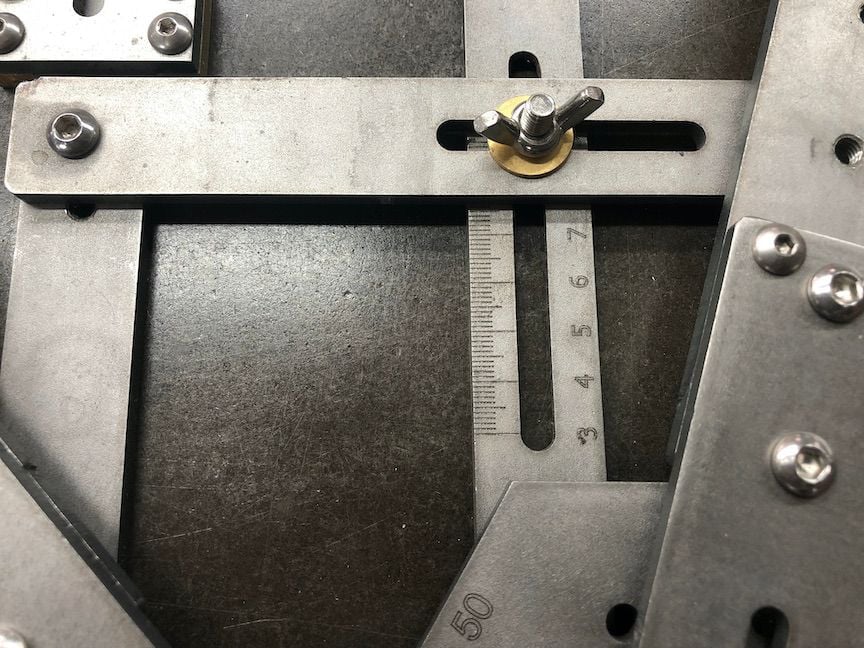
It has a BB drop of 75mm
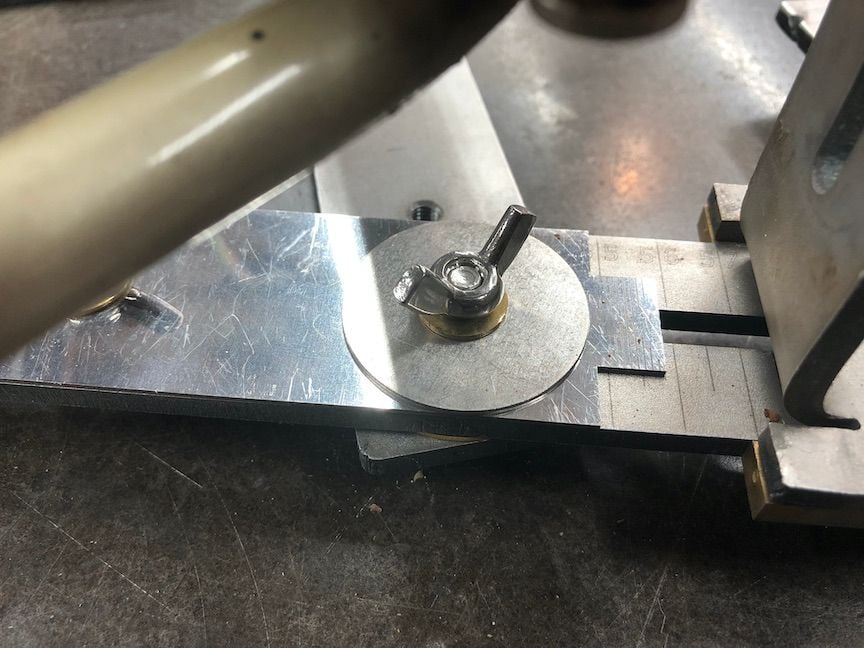
the c-c seat tube length is a hair under 56cm

The actual top tube length is a bit over 56cm

the fork rake is 50mm
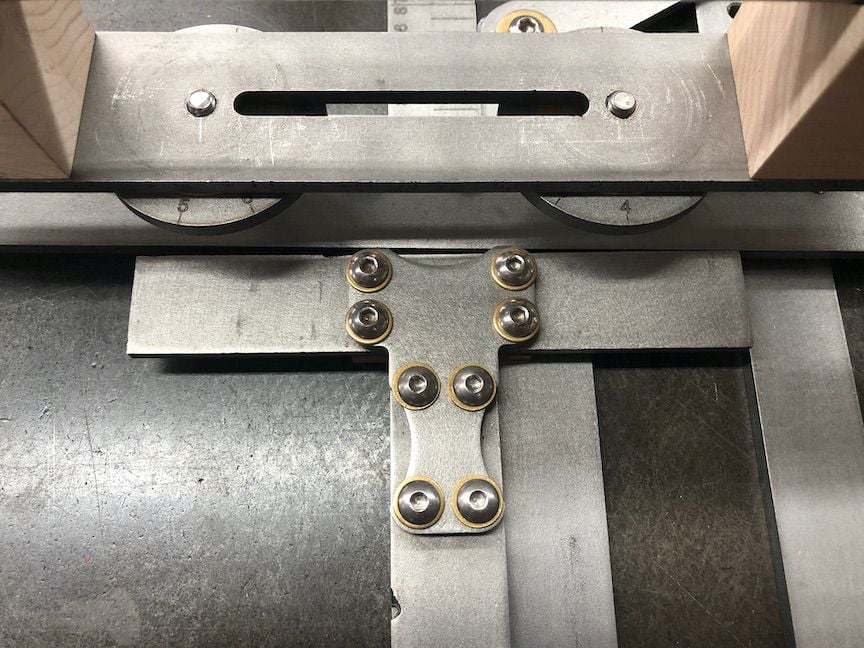
This T is to level a top tube and you can see that the top tube slops up towards the head tube.
One of the benefits I've gotten from our charity bicycle project in Ukraine is that the laser company that made our dropouts and fork crowns (and other attachments) could also help refine the design of my frame fixture before they cut and etched the pieces from a plate of stainless steel. Over many years I've been able to make a number of refinements with the help of various people. It is multifunctional. I can custom design a frame on it by placing the chosen seat and stem in the position required after a fitting session. I also can spot tubes together into a frame before fully brazing them together.
I don't mind visitors to my frame shop and have no trouble explaining any time restrictions I may have because of work obligations. If I am in the middle of a frame building class of course I have to focus on the paying customer.

A picture of my 72 Masi in my frame fixture

Its seat tube angle is 72.5º

It head tube angle is 73º

It has a BB drop of 75mm

the c-c seat tube length is a hair under 56cm

The actual top tube length is a bit over 56cm

the fork rake is 50mm

This T is to level a top tube and you can see that the top tube slops up towards the head tube.







